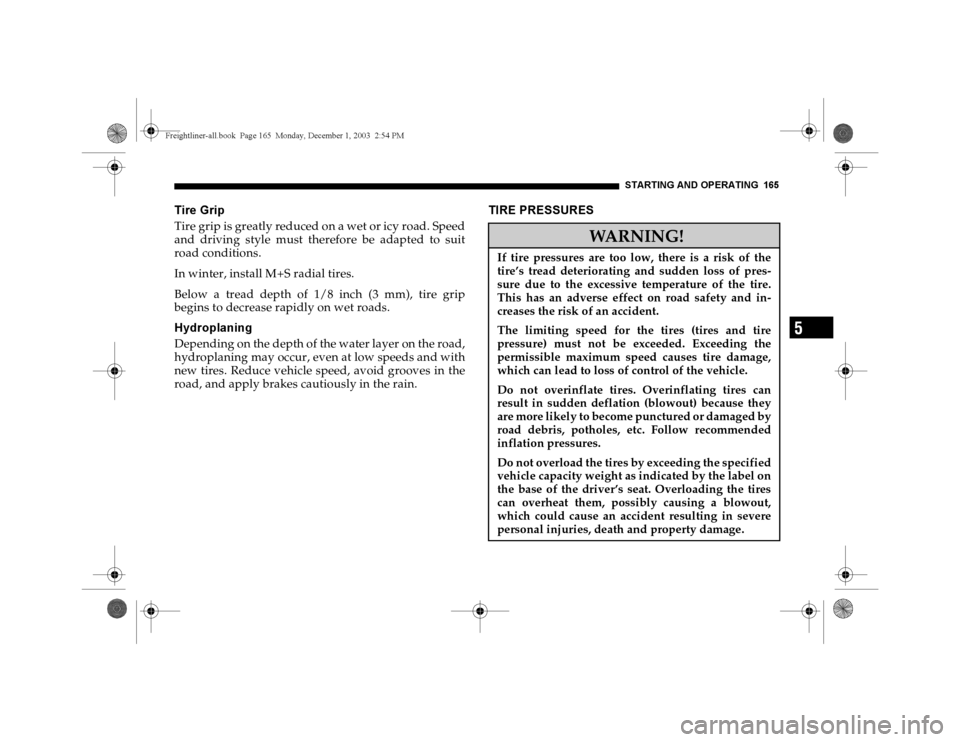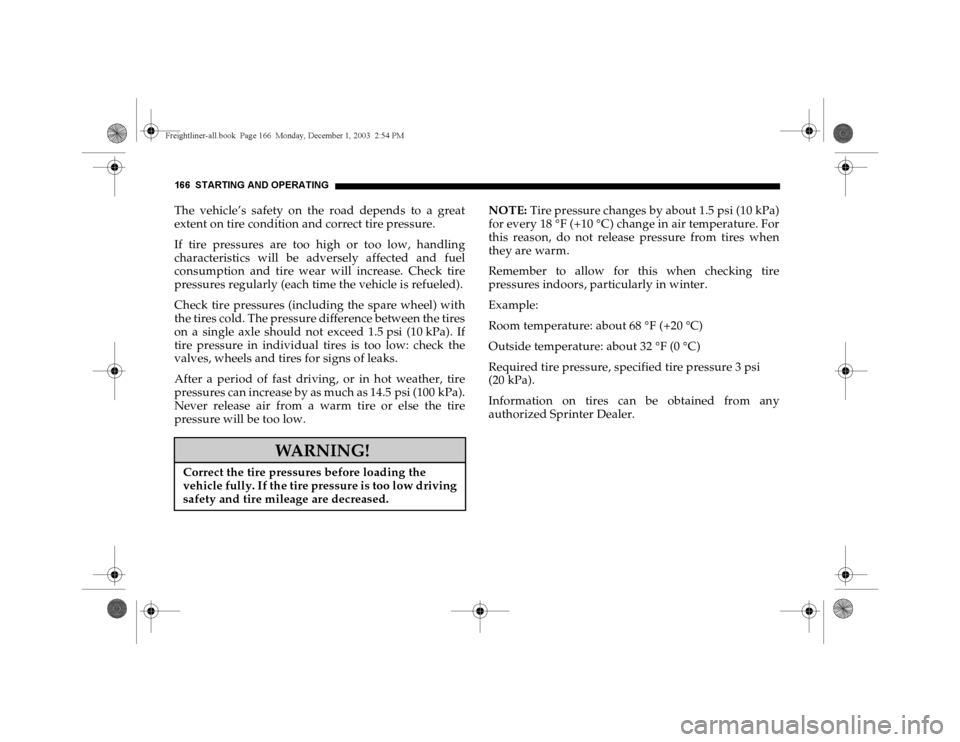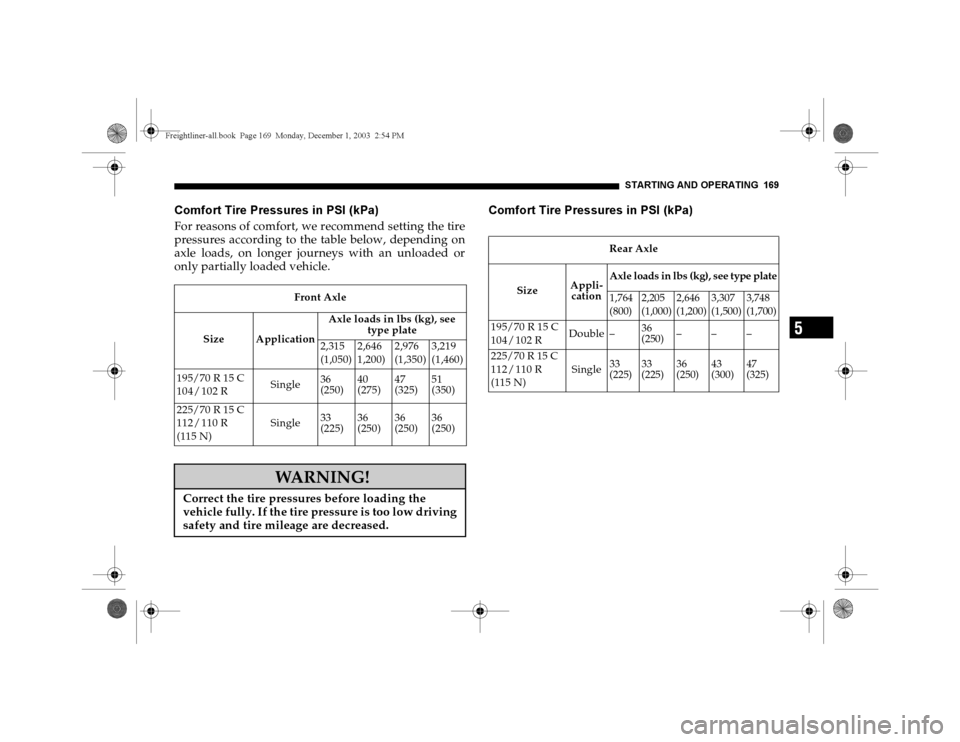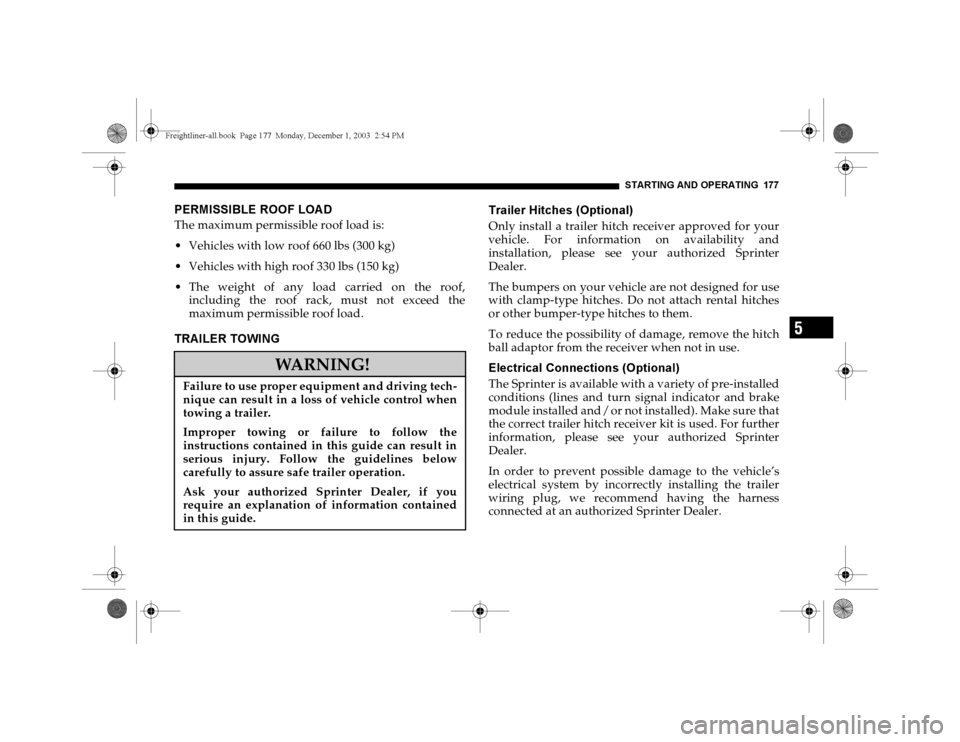Page 164 of 272

164 STARTING AND OPERATING
WARNING!
Fitting other wheel sizes to the vehicle will change
the vehicle’s handling characteristics and may
lead to an accident resulting in severe personal in-
juries, death and property damage.
Do not use retreaded/ remolded tires. This process
does not always permit previous damage to the
detected. Therefore vehicle safety cannot be
guaranteed if retreaded/remolded tires are fitted
.
WARNING!
A wheel could work loose. To avoid the risk of serious or
fatal injuries or vehicle damage, please bear the follow-
ing points in mind: Always replace wheel bolts that are damaged or
rusted.
Never apply oil or grease to wheel bolts. If a wheel hub thread is damaged, you must not drive the
vehicle. Consult a qualified specialist workshop. Be sure to use correct mounting bolts. Check
tightness of wheel bolts or nuts regularly and
retighten with a torque wrench, if necessary.
Tighten wheel bolts or nuts in a cross-pattern
sequence.Mounting bolts and tightening torque, see Chapter 12,
‘‘Installing a Wheel’’. After changing a wheel, the wheel bolts or nuts
must be tightened once the vehicle has been
driven for about 30 miles (50 km).If new or repainted wheels are fitted, the wheel bolts or
nuts must be retightened again after about 600 to 3,000
miles (about 1,000 to 5,000 km).
Freightliner-all.book Pag e 164 Monday, December 1, 2003 2:54 PM
Page 165 of 272

STARTING AND OPERATING 165
5
Tire GripTire grip is greatly reduced on a wet or icy road. Speed
and driving style must therefore be adapted to suit
road conditions.
In winter, install M+S radial tires.
Below a tread depth of 1/8 inch (3 mm), tire grip
begins to decrease rapidly on wet roads.HydroplaningDepending on the depth of the water layer on the road,
hydroplaning may occur, even at low speeds and with
new tires. Reduce vehicle speed, avoid grooves in the
road, and apply brakes cautiously in the rain.
TIRE PRESSURES
WARNING!
If tire pressures are too low, there is a risk of the
tire’s tread deteriorating and sudden loss of pres-
sure due to the excessive temperature of the tire.
This has an adverse effect on road safety and in-
creases the risk of an accident.
The limiting speed for the tires (tires and tire
pressure) must not be exceeded. Exceeding the
permissible maximum speed causes tire damage,
which can lead to loss of control of the vehicle.
Do not overinflate tires. Overinflating tires can
result in sudden deflation (blowout) because they
are more likely to become punctured or damaged by
road debris, potholes, etc. Follow recommended
inflation pressures.
Do not overload the tires by exceeding the specified
vehicle capacity weight as indicated by the label on
the base of the driver’s seat. Overloading the tires
can overheat them, possibly causing a blowout,
which could cause an accident resulting in severe
personal injuries, death and property damage.
Freightliner-all.book Pag e 165 Monday, December 1, 2003 2:54 PM
Page 166 of 272

166 STARTING AND OPERATINGThe vehicle’s safety on the road depends to a great
extent on tire condition and correct tire pressure.
If tire pressures are too high or too low, handling
characteristics will be adversely affected and fuel
consumption and tire wear will increase. Check tire
pressures regularly (each time the vehicle is refueled).
Check tire pressures (including the spare wheel) with
the tires cold. The pressure difference between the tires
on a single axle should not exceed 1.5 psi (10 kPa). If
tire pressure in individual tires is too low: check the
valves, wheels and tires for signs of leaks.
After a period of fast driving, or in hot weather, tire
pressures can increase by as much as 14.5 psi (100 kPa).
Never release air from a warm tire or else the tire
pressure will be too low.NOTE: Tire pressure changes by about 1.5 psi (10 kPa)
for every 18
°F (+10
°C) change in air temperature. For
this reason, do not release pressure from tires when
they are warm.
Remember to allow for this when checking tire
pressures indoors, particularly in winter.
Example:
Room temperature: about 68
°F (+20
°C)
Outside temperature: about 32
°F (0
°C)
Required tire pressure, specified tire pressure 3 psi
(20 kPa).
Information on tires can be obtained from any
authorized Sprinter Dealer.
WARNING!
Correct the tire pressures before loading the
vehicle fully. If the tire pressure is too low driving
safety and tire mileage are decreased.
Freightliner-all.book Pag e 166 Monday, December 1, 2003 2:54 PM
Page 169 of 272

STARTING AND OPERATING 169
5
Comfort Tire Pressures in PSI (kPa)For reasons of comfort, we recommend setting the tire
pressures according to the table below, depending on
axle loads, on longer journeys with an unloaded or
only partially loaded vehicle.
Comfort Tire Pressures in PSI (kPa)
Front Axle
Size ApplicationAxle loads in lbs (kg), see
type plate
2,315
(1,050)2,646
1,200)2,976
(1,350)3,219
(1,460)
195/70 R 15 C
104 / 102 R Single36
(250)40
(275)47
(325)51
(350)
225/70 R 15 C
112 / 110 R
(115 N)Single33
(225)36
(250)36
(250)36
(250)
WARNING!
Correct the tire pressures before loading the
vehicle fully. If the tire pressure is too low driving
safety and tire mileage are decreased.
Rear Axle
SizeAppli-
cationAxle loads in lbs (kg), see type plate1,764
(800)2,205
(1,000)2,646
(1,200)3,307
(1,500)3,748
(1,700)
195/70 R 15 C
104 / 102 RDouble
–36
(250)–––
225/70 R 15 C
112 / 110 R
(115 N)Single
33
(225)33
(225)36
(250)43
(300)47
(325)
Freightliner-all.book Pag e 169 Monday, December 1, 2003 2:54 PM
Page 172 of 272
172 STARTING AND OPERATING
REFUELINGThe fuel filler neck (1) is located behind the fuel filler
flap next to the driver’s door. The fuel filler flap can be
opened when the driver’s door is open. Turn the fuel
filler cap (2) on the fuel filler neck (1) counterclockwise
and take it off. For cargo/passenger vans, place the
fuel filler cap (2) in the holder on the inside of the fuel
filler flap.
When you have finished refueling, install the fuel filler
cap (2).
WARNING!
Under no circumstances should gasoline be mixed
with diesel fuel.
Due to the high pressure and high temperature in
the injection system, there is a risk of fire and
explosion.
In addition, there is a risk of engine damage.
Always follow basic safety rules when working
with any combustible material.
Freightliner-all.book Pag e 172 Monday, December 1, 2003 2:54 PM
Page 173 of 272

STARTING AND OPERATING 173
5
NOTE: Only fill the fuel tank until the fill nozzle cuts
off, do not overfill.
NOTE: Holder on the inside of the fuel filler flap only
for cargo/passenger vans.
CapacityFuel tank including reserve fuel about 26.4 US gal
(100 l).PROGRAMMED TOP SPEED (OPTIONAL)NOTE: The top speed of this vehicle can be
electronically limited to a speed between 19 mph
(30 km / h) and 82 mph (132 km / h). The vehicle’s
electronic speed controller should be programmed
only by a qualified technician by an authorized
Sprinter Dealer.
When programming the electronic speed controller,
the circumference of the specific tires actually mounted
on the vehicle must be determined and that
circumference must be correctly programmed into the
vehicle’s electronic speed controller. It is critical that
the correct tire circumference be programmed
accurately into the vehicle’s electronic speed
controller. Accurate tire circumference information
should be confirmed each time the electronic speed
controller is programmed and each time new wheels or
tires are mounted on the vehicle.
WARNING!
Always handle fuel with great care.
Shut off the engine and the auxiliary heater before
refueling.
Fuel is flammable and explosive. Keep open
flames away from the fuel.
Refrain from smoking as well as use of any
electrical equipment (such as cell phones). This
also applies to places where the characteristic
smell of fuel is evident.
If diesel fumes are noticed inside the vehicle, have
the cause traced and rectified immediately by an
authorized Sprinter Dealer.
Freightliner-all.book Pag e 173 Monday, December 1, 2003 2:54 PM
Page 174 of 272

174 STARTING AND OPERATING
BLEEDING DIESEL FUEL SYSTEMIf the fuel tank was run empty, the diesel fuel system
must be bled after refueling before starting the engine.– Turn the key in the ignition lock to position 2 for at
least 30 seconds.– Return the key to position 0.– Start the engine.
NOTE: Too many attempts to start the engine could
drain the battery. If the engine does not start after
several attempts, consult an authorized Sprinter
Dealer.
WARNING!
Possible tire damage resulting in serious personal
injury or death may occur if the vehicle’s electron-
ic speed controller is programmed at a speed
above the maximum speed allowed by the manu-
facturer of the specific tires mounted on the vehi-
cle. The maximum speed of the tires prescribed by
the tire manufacturer must be determined and ac-
curately programmed into the electronic speed
controller. The electronic speed controller must
never be programmed at a speed greater than the
maximum allowable tire speed as prescribed by
the manufacturer of the specific tires mounted on
the vehicle.
Freightliner-all.book Pag e 174 Monday, December 1, 2003 2:54 PM
Page 177 of 272

STARTING AND OPERATING 177
5
PERMISSIBLE ROOF LOADThe maximum permissible roof load is:
Vehicles with low roof 660 lbs (300 kg)
Vehicles with high roof 330 lbs (150 kg)
The weight of any load carried on the roof,
including the roof rack, must not exceed the
maximum permissible roof load.TRA I LER TOWI NGTrailer Hitches (Optional)
Only install a trailer hitch receiver approved for your
vehicle. For information on availability and
installation, please see your authorized Sprinter
Dealer.
The bumpers on your vehicle are not designed for use
with clamp-type hitches. Do not attach rental hitches
or other bumper-type hitches to them.
To reduce the possibility of damage, remove the hitch
ball adaptor from the receiver when not in use.Electrical Connections (Optional)The Sprinter is available with a variety of pre-installed
conditions (lines and turn signal indicator and brake
module installed and / or not installed). Make sure that
the correct trailer hitch receiver kit is used. For further
information, please see your authorized Sprinter
Dealer.
In order to prevent possible damage to the vehicle’s
electrical system by incorrectly installing the trailer
wiring plug, we recommend having the harness
connected at an authorized Sprinter Dealer.
WARNING!
Failure to use proper equipment and driving tech-
nique can result in a loss of vehicle control when
towing a trailer.
Improper towing or failure to follow the
instructions contained in this guide can result in
serious injury. Follow the guidelines below
carefully to assure safe trailer operation.
Ask your authorized Sprinter Dealer, if you
require an explanation of information contained
in this guide.
Freightliner-all.book Pag e 177 Monday, December 1, 2003 2:54 PM